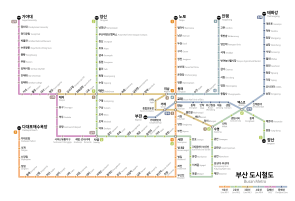Busan subway facts for kids
Quick facts for kids Busan Metro |
|||
|---|---|---|---|
 Busan Subway Line 2.jpg |
|||
| Info | |||
| Owner | City of Busan | ||
| Locale | Busan, South Korea | ||
| Transit type | Rapid transit, Commuter rail | ||
| Number of lines | 6 | ||
| Number of stations | 114 (metro only) 149 (incl. BGL, Donghae Line) |
||
| Daily ridership | 904,350(2016, metro only) | ||
| Operation | |||
| Began operation | 19 July 1985 | ||
| Operator(s) | Busan Transportation Corporation B&G Metro Korail |
||
| Technical | |||
| System length | 116.5 km (72.4 mi) (metro only) 168.4 km (104.6 mi) (incl. BGL, Donghae Line) |
||
| Track gauge | 1,435 mm (4 ft 8 1⁄2 in) standard gauge | ||
|
|||
| Busan Metro | |
| Hangul | |
|---|---|
| Hanja | |
| Revised Romanization | Busan dosicheoldo |
| McCune–Reischauer | Pusan tosich'ŏlto |
The Busan Metro (Korean: 부산 도시철도; Hanja: 釜山 都市鐵道; RR: Busan dosicheoldo) is a subway system in Busan, South Korea. It helps people travel quickly around the city. Busan is one of four cities in South Korea that has a subway. The others are Seoul, Daegu, and Incheon.
Planning for the Busan Metro started in 1979. Construction began in 1981. The first part of the subway opened on July 19, 1985. This first line was 16.2 kilometers (10.1 miles) long. It had 17 stations. Today, the Busan Metro has 114 stations and six lines. It covers a total of 168.4 kilometers (104.6 miles) of tracks. The system is run by the Busan Transportation Corporation. They also use the brand name 'Humetro'.
Contents
Busan Metro Lines: A Quick Guide
The Busan Metro has several lines. Each line connects different parts of the city. Some lines are operated by the Busan Transportation Corporation. Other lines are run by different companies.
| Operator | Line Name English |
Line Name Korean |
Starting Station | Ending Station | Stations | Total Length |
|---|---|---|---|---|---|---|
| Busan Transportation Corporation |
|
1호선 | Dadaepo Beach | Nopo | 40 | 40.5 km |
|
|
2호선 | 2호선 | Jangsan | Yangsan | 43 | 45.2 km |
|
|
3호선 | 3호선 | Suyeong | Daejeo | 17 | 18.1 km |
|
|
4호선 | 4호선 | Minam | Anpyeong | 14 | 12.7 km |
| Subtotal | 114 | 116.5 km | ||||
| B&G Metro |
|
부산-김해 경전철 |
Sasang | Kaya University | 21 | 23.4 km |
|
|
동해선 | Bujeon | Ilgwang | 14 | 28.5 km | |
| Grand Total | 149 | 168.4 km | ||||
Exploring Busan Metro Lines
Each metro line in Busan has its own unique features. They help connect different parts of the city.
Line 1: The Orange Line
Line 1 was the first metro line to open in Busan. It started running in 1985. This line goes from Nopo-dong to Dadaepo Beach. It is a very important route. It passes right through the center of Busan. Line 1 is 40.5 kilometers (25.2 miles) long. It has 40 stations. The trains on Line 1 have 8 cars.
Line 2: The Green Line
Line 2 began operating in 1999. This line helps people travel from the east to the west side of Busan. It goes from Jangsan to Yangsan. In 2008, the line was extended to connect Busan with Yangsan city. Line 2 is 45.2 kilometers (28.1 miles) long. It has 43 stations. The trains on Line 2 have 6 cars.
Line 3: The Brown Line
Line 3 opened in 2005. Its main goal is to reduce traffic in areas like Mandeok and Minam. It also connects the Gangseo area to the city center. This helps improve life for people in Gangseo. Line 3 is 18.1 kilometers (11.2 miles) long. It has 17 stations. The trains on Line 3 have 4 cars. These trains are a special Korean standard type. They are also lighter than the trains on Line 1.
Line 4: The Blue Line
Line 4 started service in 2011. It connects Minam to Anpyeong. This line is 12.7 kilometers (7.9 miles) long. It has 14 stations. Line 4 uses a special type of train called a light rail. Light rail systems are cheaper to build and manage than regular heavy rail subways.
Busan-Gimhae Light Rail Transit
This light rail line connects Busan to the nearby city of Gimhae. It runs from Sasang to Gaya University. This line has 21 stations. It is 23.4 kilometers (14.5 miles) long. It helps people travel easily between the two cities.
Donghae Line
The Donghae Line is operated by Korail. It connects Bujeon Station to Ilgwang Station. This line has 14 stations. It is 28.5 kilometers (17.7 miles) long. It provides another important travel option for people in Busan.
Who Uses the Busan Metro?
Many people use the Busan Metro every day. In 2009, about 722,000 people used the subway each day. That's over 263 million passengers in a year! Line 1 is the busiest line. Line 2 is also very popular.
Related pages


